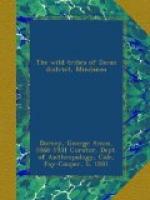[1] See LING ROTH, Oriental Silver Work.
Not once did the writer receive a name for any pattern or design shown in metal work. A careful study of the method of work, of the articles produced, and of the folk-lore and religious observances connected with the work in brass and copper brings one to the conclusion that this class of work is of comparatively recent introduction and that the instructors in the art were the Samal Moro.
Mention has already been made of the designs incised on combs and other objects which are afterwards filled with lime. Just here it is interesting to note that, so far as is known, the southern end of Mindanao and adjacent small islands, are the only parts of the Philippines in which this decoration, so typical of Melanesia, is to be found.
Realistic carvings were seen used in only two capacities. The first in certain ceremonies, where extremely crude wooden figures were offered to the spirits in exchange for the sick person (see p. 103), and the second, the wooden decoys used in hunting doves (See Plate XVIII).
Summing up our present information we can say: first, that the Bagobo makes use of certain realistic designs which in some cases have become conventionalized but still retain their former significance; second, that the greater part of decoration in beads, shell disks, embroidery or applique, as well as the incised designs in lime boxes and the like, have no meaning to the people of the present day, and are added only to make the objects more beautiful in the eyes of the owners. In this work there are no set patterns and each artist gives full reign to the fancy in producing these figures. Third, that the ideas for the patterns inlaid, incised, and cast in brass or copper, are furnished by the examples of this work coming from the Malays to the south, but that even in these the artist has taken great liberties in the execution of the design. Fourth, that one type of decoration, i. e., the incised figures filled with lime, suggests the possible influence of Melanesia on the artistic ideas of this people.
MYTHOLOGY.
During my stay with this tribe I heard parts of many folk-tales, some chanted, others told with gravity, and still others which caused the greatest levity. My limited knowledge of the dialect and pressure of other work caused me to delay the recording of these tales until I should begin a systematic study of the language. Owing to unforeseen circumstances, that time never came, and it is now possible to give only the slightest idea of a very rich body of tales.[1]




